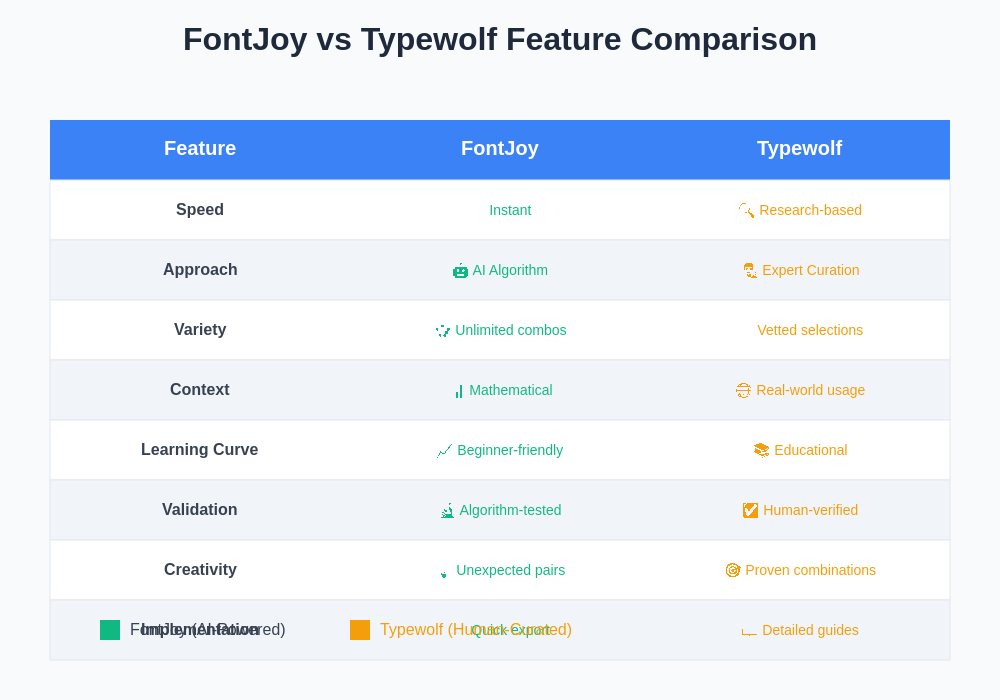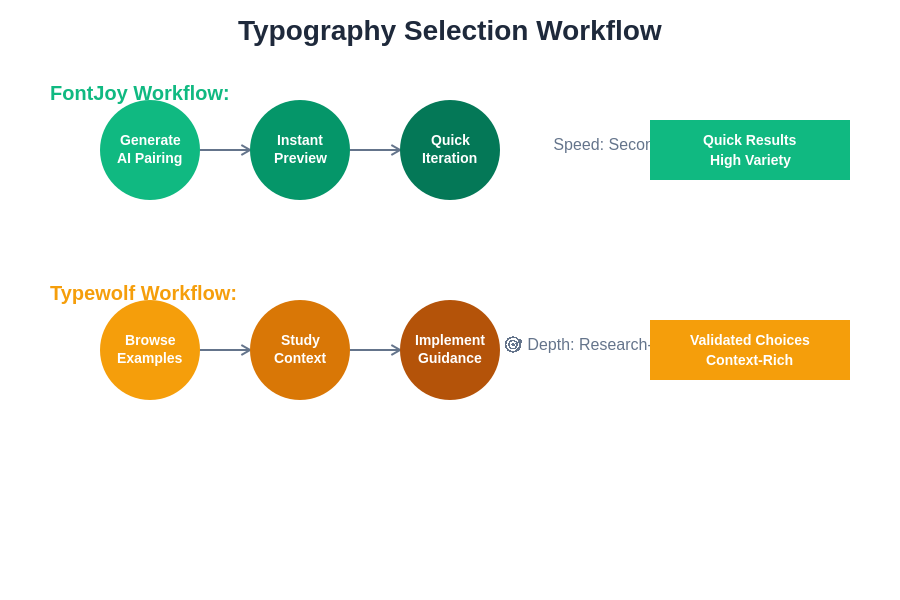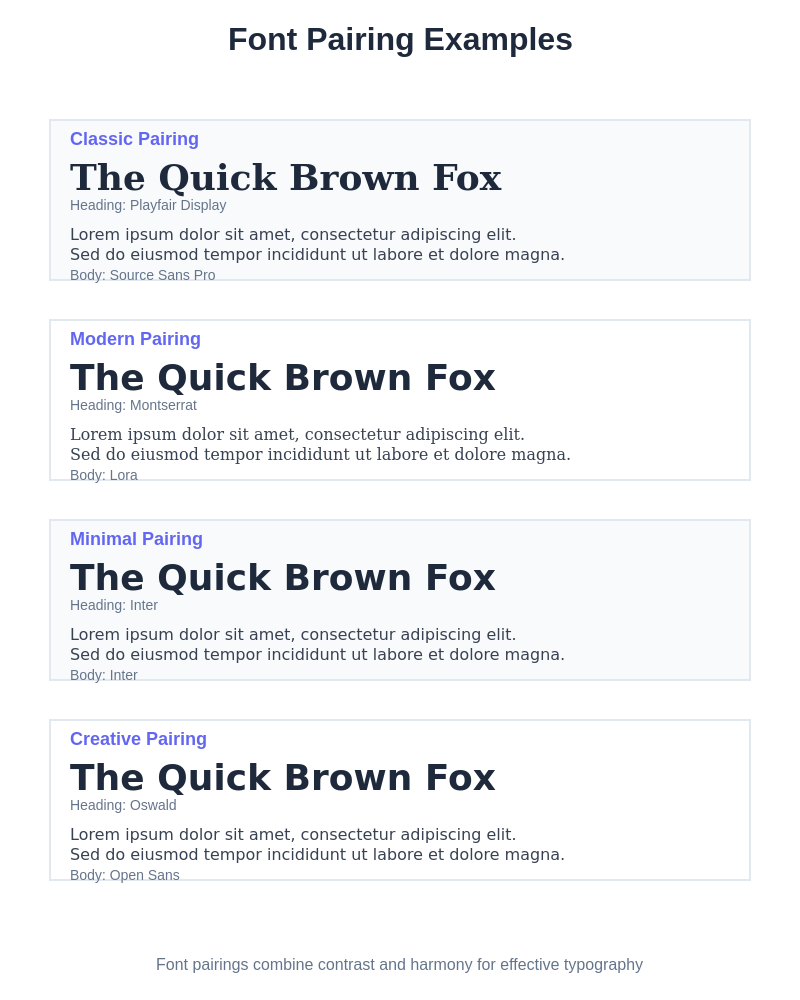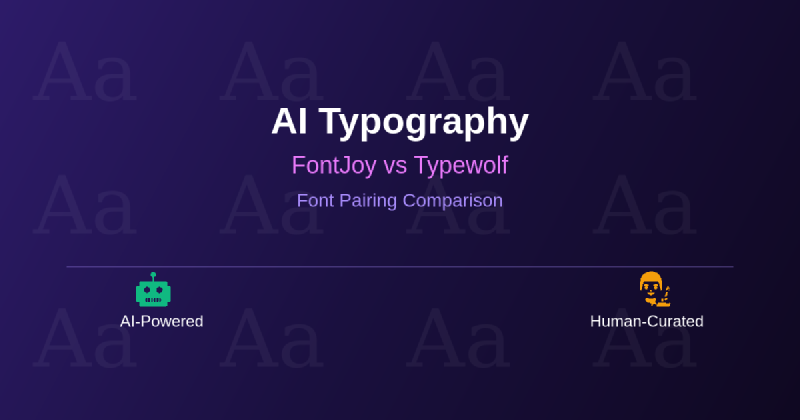Typography has emerged as one of the most critical elements in modern design, with the power to transform ordinary content into visually compelling narratives that engage audiences and communicate brand identity effectively. The evolution of artificial intelligence has revolutionized how designers approach font selection and pairing, introducing sophisticated tools that combine algorithmic precision with aesthetic sensibility to create harmonious typographic compositions that would traditionally require years of design expertise to achieve.
Explore the latest AI design trends to discover cutting-edge typography innovations that are reshaping visual communication across digital and print media. The intersection of artificial intelligence and typography represents a fundamental shift in design methodology, where machine learning algorithms analyze countless font combinations to suggest pairings that balance readability, visual hierarchy, and aesthetic appeal with unprecedented accuracy and speed.
The Evolution of Digital Typography
The digital typography landscape has undergone remarkable transformation since the early days of desktop publishing, evolving from limited font libraries and basic text formatting capabilities to sophisticated typographic ecosystems that offer unprecedented creative possibilities. Traditional font pairing required extensive knowledge of typographic principles, historical context, and visual design theory, often taking designers considerable time to identify complementary typefaces that work harmoniously together while maintaining readability and visual appeal across different contexts and applications.
Modern typography tools have democratized access to professional-grade font pairing capabilities by leveraging artificial intelligence to analyze fundamental design principles such as contrast, hierarchy, rhythm, and balance. These AI-powered systems can evaluate thousands of font combinations in seconds, considering factors like x-height relationships, stroke width variations, character spacing, and overall visual weight to recommend pairings that achieve both functional effectiveness and aesthetic sophistication.
The emergence of AI-driven typography tools has particularly benefited designers working under tight deadlines, small design teams lacking specialized typography expertise, and non-designers who need to create professional-looking materials without extensive design training. This democratization of typography knowledge has resulted in higher quality visual communications across industries while simultaneously raising the overall standard of typographic design in digital media.
FontJoy: AI-Powered Font Harmony
FontJoy represents a groundbreaking approach to font pairing through its sophisticated artificial intelligence engine that generates harmonious typography combinations with remarkable speed and accuracy. The platform utilizes machine learning algorithms trained on thousands of successful font pairings to understand the underlying principles that make certain typeface combinations visually effective and aesthetically pleasing across diverse design contexts and applications.
The AI engine behind FontJoy analyzes multiple typographic characteristics including letterform structure, stroke contrast, character proportions, and visual rhythm to identify fonts that complement each other while maintaining distinct personalities. This analytical approach goes beyond simple categorization by examining subtle visual relationships between typefaces, such as how different fonts handle similar letterforms, their approach to spacing and kerning, and their overall visual weight distribution.
Enhance your design workflow with Claude’s AI capabilities for comprehensive design analysis and creative problem-solving that complements font selection with strategic design thinking. FontJoy’s strength lies in its ability to generate unexpected yet harmonious combinations that human designers might not immediately consider, expanding creative possibilities while maintaining typographic best practices and ensuring readability across different media and viewing conditions.
The platform’s intuitive interface allows designers to generate new combinations instantly, adjust individual fonts within pairings, and experiment with different styles until finding the perfect typographic solution for their specific project requirements. FontJoy’s AI continuously learns from user interactions and feedback, improving its recommendation accuracy and expanding its understanding of contemporary design trends and preferences.
Typewolf: Curated Typography Excellence
Typewolf approaches font pairing from a distinctly human-centered perspective, combining expert curation with extensive real-world analysis to provide typography recommendations based on successful implementations across thousands of websites and design projects. Rather than relying solely on algorithmic analysis, Typewolf leverages the expertise of professional typographers and design analysts who manually review and categorize font combinations based on their effectiveness in actual design applications.
The platform’s strength lies in its comprehensive database of real-world typography usage, providing context and inspiration through detailed case studies that showcase how specific font pairings perform across different industries, design styles, and communication objectives. This empirical approach offers valuable insights into typography trends, helping designers understand not just which fonts work well together, but why certain combinations are effective in specific contexts and how they contribute to overall design success.
Typewolf’s curated approach extends beyond simple font recommendations to include detailed analysis of typography implementation, including optimal sizing relationships, spacing considerations, and color applications that maximize the impact of chosen font pairings. The platform provides extensive documentation of successful typography usage across various media types, from web design and mobile applications to print materials and branding applications.
The human expertise embedded in Typewolf’s recommendations ensures that suggested font pairings have been tested in real-world scenarios and proven effective for actual design projects. This validation process provides designers with confidence that chosen typography combinations will perform well across different contexts while maintaining professional standards and aesthetic appeal.
Comparative Analysis: AI vs Human Expertise
The fundamental difference between FontJoy’s AI-driven approach and Typewolf’s human-curated methodology represents two distinct philosophies in typography selection and design guidance. FontJoy’s artificial intelligence excels at identifying mathematical relationships between fonts, analyzing structural similarities and differences that create visual harmony through algorithmic precision and pattern recognition capabilities that can process vast amounts of typographic data instantaneously.
FontJoy’s AI approach offers several distinct advantages including speed of generation, ability to create unexpected combinations, and consistent availability for experimentation and iteration. The platform can analyze thousands of potential font combinations in seconds, providing designers with multiple options to explore and refine according to their specific project requirements and aesthetic preferences.
Typewolf’s human-curated approach provides contextual understanding that goes beyond mathematical relationships to include cultural associations, brand appropriateness, and real-world performance metrics gathered from successful design implementations. The platform’s expert analysis considers factors that algorithmic systems might miss, such as subtle cultural connotations of certain typefaces, industry-specific preferences, and evolving design trends that require human interpretation and judgment.
The human expertise in Typewolf’s curation process ensures that recommended font pairings have been validated through actual design projects and proven effective in real-world applications. This validation provides an additional layer of confidence for designers working on critical projects where typography choices can significantly impact communication effectiveness and brand perception.
Technical Capabilities and Features
FontJoy’s technical architecture demonstrates sophisticated machine learning implementation through its neural network system that processes typographic characteristics using advanced pattern recognition algorithms. The platform analyzes font metadata, visual characteristics, and structural relationships to generate recommendations that balance mathematical precision with aesthetic sensibility, creating a unique hybrid approach that combines quantitative analysis with qualitative design principles.
The AI system continuously improves its recommendations through user feedback and interaction data, learning from designer preferences and successful font pairings to refine its algorithmic approach. This machine learning capability ensures that FontJoy’s recommendations evolve and improve over time, adapting to changing design trends and user preferences while maintaining consistency in typographic quality and effectiveness.

The fundamental differences between these platforms become clear when examining their core features and methodologies side by side. Each approach offers distinct advantages that serve different aspects of the design process and cater to varying user requirements and project constraints.
Discover advanced AI research capabilities with Perplexity to explore deeper typography research and trend analysis that supports informed font selection decisions. FontJoy’s technical capabilities include real-time font preview generation, customizable pairing parameters, and integration capabilities that allow designers to export font selections directly to design software and web development platforms.
Typewolf’s technical infrastructure focuses on comprehensive database management and content curation systems that organize and present vast amounts of typography information in accessible and actionable formats. The platform’s strength lies in its extensive documentation system that captures detailed information about font usage, implementation details, and performance metrics across thousands of design projects and websites.
The platform’s search and filtering capabilities allow designers to find relevant font pairings based on specific criteria such as industry, design style, or technical requirements. Typewolf’s database includes detailed licensing information, technical specifications, and implementation guidelines that support professional design workflows and ensure proper font usage across different media and applications.
User Experience and Interface Design
FontJoy prioritizes simplicity and speed in its user interface design, providing an intuitive experience that allows designers to generate and experiment with font pairings without technical complexity or steep learning curves. The platform’s clean, minimalist interface focuses attention on typography samples while providing essential controls for customization and refinement of generated pairings.
The user experience emphasizes rapid iteration and experimentation, with immediate visual feedback that allows designers to quickly assess the effectiveness of different font combinations. FontJoy’s interface includes features such as real-time preview updates, easy font substitution within pairings, and quick sharing capabilities that support collaborative design workflows and client presentations.
Typewolf’s interface design reflects its editorial and curatorial approach, presenting typography information through a magazine-like format that combines visual examples with detailed analysis and commentary. The platform’s design emphasizes content discovery and education, providing extensive context and background information that helps designers understand the reasoning behind font pairing recommendations and learn broader typographic principles.

The distinct workflows employed by each platform reflect their underlying philosophies and target user needs. FontJoy emphasizes rapid generation and iteration, while Typewolf focuses on research-based exploration and contextual understanding of typography choices.
The user experience includes comprehensive filtering and search capabilities that allow designers to explore typography examples based on specific criteria and requirements. Typewolf’s interface supports both browsing for inspiration and targeted searching for specific typography solutions, accommodating different user workflows and design processes.
Practical Applications and Use Cases
FontJoy’s AI-powered approach proves particularly valuable for projects requiring rapid typography exploration, such as initial design concepts, client presentations, and deadline-driven projects where quick iteration and multiple options are essential. The platform excels in scenarios where designers need to explore unconventional font combinations or break away from predictable typography choices while maintaining professional quality and readability standards.
The AI system’s ability to generate unexpected yet harmonious combinations makes it especially useful for creative projects, experimental designs, and situations where designers want to explore typography possibilities beyond their immediate expertise or experience. FontJoy’s speed and efficiency support agile design workflows where rapid prototyping and quick decision-making are critical for project success.
Typewolf’s curated approach provides exceptional value for projects where typography choices require careful consideration of brand alignment, industry appropriateness, and proven effectiveness. The platform’s real-world validation and expert analysis make it particularly suitable for corporate design projects, brand identity development, and situations where typography choices need to align with established design standards and expectations.
The platform’s extensive case studies and implementation examples provide valuable guidance for complex typography challenges, such as multi-language design requirements, accessibility considerations, and cross-platform consistency. Typewolf’s educational content supports long-term skill development and helps designers build deeper understanding of typography principles that extend beyond specific project requirements.
Performance Metrics and Effectiveness
FontJoy’s effectiveness can be measured through its ability to generate aesthetically pleasing and functionally effective font pairings consistently and rapidly. User feedback and design community adoption indicate strong satisfaction with the AI system’s recommendations, particularly for creative exploration and initial design development phases where speed and variety are prioritized over extensive validation and contextual analysis.
The platform’s algorithmic approach ensures consistent quality across all generated recommendations, with mathematical precision that eliminates obviously poor combinations while maintaining creative diversity in suggested pairings. FontJoy’s effectiveness is particularly evident in its ability to introduce designers to fonts they might not have considered while ensuring that suggested combinations meet basic readability and aesthetic standards.
Typewolf’s effectiveness is demonstrated through the proven success of its curated font pairings in real-world design applications and the platform’s influence on typography trends across the design community. The platform’s recommendations carry additional weight due to their validation through actual design projects and expert analysis, providing confidence for designers working on high-stakes projects where typography choices significantly impact communication effectiveness.
The platform’s educational impact extends beyond immediate font pairing assistance to include long-term skill development and typography knowledge that benefits designers throughout their careers. Typewolf’s effectiveness includes its role as a learning resource that helps designers understand the reasoning behind successful font combinations and develop independent typography judgment and expertise.
Integration and Workflow Compatibility
FontJoy’s design prioritizes seamless integration with existing design workflows through features such as direct font export capabilities, CSS code generation for web projects, and compatibility with popular design software platforms. The platform’s technical approach supports both individual designer workflows and collaborative team environments where font selections need to be shared and implemented across different tools and platforms.
The platform’s API capabilities and integration options allow for incorporation into larger design systems and automated workflows where typography selection is part of broader design automation initiatives. FontJoy’s technical architecture supports scalable implementation across different project types and organizational structures while maintaining consistency in font pairing quality and effectiveness.
Typewolf’s integration approach focuses on providing comprehensive information and resources that support informed decision-making within existing design workflows rather than attempting to automate or streamline the selection process. The platform’s detailed documentation and implementation guidance help designers effectively incorporate selected font pairings into their projects while understanding the contextual factors that contribute to typography success.
The platform’s educational resources and trend analysis support strategic typography decision-making at the organizational level, helping design teams develop consistent typography standards and guidelines that align with brand objectives and communication goals. Typewolf’s approach supports long-term typography strategy development rather than just immediate pairing selection.
Future Developments and Industry Impact
The continued evolution of AI-powered typography tools like FontJoy represents broader trends toward intelligent design assistance that augments human creativity rather than replacing designer expertise and judgment. Future developments in machine learning and neural network technology promise even more sophisticated typography analysis capabilities that could incorporate cultural context, emotional response, and brand alignment factors into algorithmic recommendations.
The success of AI typography tools is likely to influence broader design software development, with major platforms potentially incorporating similar intelligent assistance features that help designers make more informed typography choices. This evolution could lead to more democratized access to professional-quality typography while simultaneously raising overall design standards across different industries and applications.
Typewolf’s human-curated approach will likely continue to evolve through expanded analysis capabilities, broader coverage of typography trends, and deeper integration with design education and professional development resources. The platform’s influence on typography culture and design standards positions it as a continued leader in design education and trend identification that shapes industry practices and preferences.
The combination of AI-powered tools like FontJoy and expert-curated resources like Typewolf creates a comprehensive ecosystem for typography selection and education that serves different needs and workflow requirements. This diversity in approach ensures that designers have access to appropriate tools for various project types and skill levels while supporting continued innovation and improvement in typography practices.
Making the Right Choice for Your Projects
Selecting between FontJoy and Typewolf depends largely on specific project requirements, timeline constraints, and design objectives that vary significantly across different types of creative work. FontJoy’s AI-powered approach provides exceptional value for rapid exploration, creative experimentation, and projects where speed and variety in font options are prioritized over extensive validation and contextual analysis of typography choices.
The platform excels in scenarios where designers need to quickly generate multiple typography options for client presentations, explore unconventional font combinations, or work within tight deadlines that don’t allow for extensive research and analysis. FontJoy’s ability to produce consistently high-quality recommendations makes it particularly valuable for less experienced designers who may lack extensive typography knowledge but need professional-quality results.
Typewolf’s curated approach provides superior value for projects where typography choices require careful brand alignment, industry-specific considerations, and proven effectiveness in similar applications. The platform’s expert analysis and real-world validation make it essential for corporate design projects, brand identity development, and situations where typography decisions have significant business implications and long-term consequences.
The educational value of Typewolf makes it particularly beneficial for designers seeking to develop deeper typography expertise and understanding of design principles that extend beyond immediate project requirements. The platform’s comprehensive analysis and trend documentation support strategic design thinking and informed decision-making that improves overall design quality and professional development.
The optimal approach for many designers involves leveraging both platforms’ strengths through a combined workflow that utilizes FontJoy for initial exploration and rapid ideation followed by Typewolf research for validation, refinement, and implementation guidance. This hybrid approach maximizes the benefits of AI-powered generation while incorporating human expertise and real-world validation to ensure typography choices achieve both aesthetic appeal and functional effectiveness.

Successful font pairing requires understanding the relationship between different typeface characteristics and how they work together to create visual hierarchy, readability, and aesthetic appeal. These examples demonstrate various approaches to combining fonts that achieve both contrast and harmony in typography design.
Conclusion
The landscape of typography selection has been fundamentally transformed by the emergence of sophisticated tools that combine artificial intelligence capabilities with human expertise to create more effective and accessible font pairing solutions. FontJoy and Typewolf represent complementary approaches to typography selection that serve different needs within the design community while contributing to overall improvement in typographic quality and design standards across various media and applications.
The future of typography tools lies not in choosing between AI-powered automation and human-curated expertise, but in understanding how these different approaches can work together to support more effective design workflows and better typography decisions. The continued evolution of both artificial intelligence capabilities and human curatorial expertise promises even more sophisticated and helpful typography resources that will benefit designers at all skill levels and across all types of creative projects.
Disclaimer
This article is for informational purposes only and does not constitute professional design advice. The effectiveness of typography tools may vary based on specific project requirements, user expertise, and design objectives. Readers should evaluate tools based on their individual needs and consider multiple resources when making important typography decisions for professional projects.
